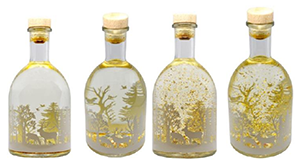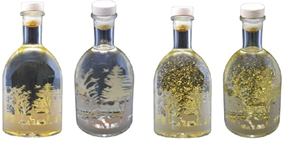Aldi’s copycat gin confirmed as infringing M&S’s registered designs: Court of Appeal guidance on UK registered design infringement
The Court of Appeal has upheld the Intellectual Property Enterprise Court’s (IPEC) decision, and found Aldi to have infringed four of Marks & Spencer’s (M&S) registered designs for its light up festive gin product.
The Court of Appeal set out some useful guidance on design infringement in relation to identifying the scope of protection, the effect of the grace period, and the relevant date for assessing the design corpus.
The key guidance can be summarised as follows:
- In identifying the scope of a registered design, in order to provide clarity, the court may rely on the “indication of product” filed alongside the registration and also make inspections of the product itself.
- The grace period relating to disclosures by the designer applies to both assessing the validity of a registered design as well as considering infringement.
- In the grace period, any of the designer’s publically disclosed designs which do not produce a different overall impression to that of the registered design are to be disregarded (and not all disclosures by the designer or just disclosures of the registered design). Consequently, if designers test market a number of distinct designs, but only decide to register one, they must accept the risk that the other designs may in some cases affect the scope of protection of the registered design.
- When assessing the overall impression of a registered design, generally, the date of assessment should be the registered design’s filing date, however, where there is a priority date the date of assessment shall be the priority date.
- If a product visibly changes states, it is beneficial to have registered designs covering each state.
The registered designs’ scope of protection
The scope of protection of a registered design depends on the proper interpretation of the registration, and in particular of the images included in that registration.
M&S had four distinct registered designs depicting the same product:


The images in each design were photographs of M&S’s gin product, each showing two different perspectives, and the design claimed consisted of the features visible, for example, shape, colours and ornamentation. Each registration was to be separately considered (as it is impermissible to interpret a registration by reference to another or amalgamate different registrations).
Interpreting M&S’s registered designs
With regard to the scope of protection, the Court of Appeal rejected Aldi’s claim that UK 82 and UK 84 depicted a dark bottle and/or liquid (and instead upheld the trial judge’s finding that they depicted clear bottles and clear liquid against a dark background). The Court of Appeal affirmed this finding on the basis of specific visible elements, such as the gap between the liquid and the lid, and highlighted that the images had clearly been edited to remove the background outside the shape of the bottle. Moreover, the Court of Appeal found that UK 78 and UK 80 demonstrated and included an integrated light system within the design (previously the trial judge had limited this finding to UK 82 and UK 84).
Notably, the Court of Appeal’s conclusions were confirmed by inspections of the M&S product. The Court of Appeal highlighted previous case law that provided that “it is not mistaken, in the assessment of the overall impression of the designs at issue, to take account of the goods actually marketed which correspond to those designs” (C-281/10 PepsiCo Inc v Grupo Promer Mon Graphic SA). However, it was highlighted that it would be different if the product marketed by the proprietor had more than a minimal difference from the pertinent registered design.
Moreover, the Court of Appeal found that the “indication of product” (provided with the registered design) can be relied upon to resolve an ambiguity as to what is shown in the image, and in that sense to assist in the interpretation of the design. On the facts, the statement applied was a “light up gin bottle”, which was found to provide an unambiguous answer as to what the design contained.
Infringement
The proprietor of a registered design has the exclusive right to use the design and any design which does not produce on the informed user a different overall impression.
The overall impression assessment is dictated by several factors such as the relevant sector of the products, the informed user, the designer’s design freedom, features dictated by function and earlier designs that have been made available to the public (the “design corpus”). Notably, the informed user may attach different degrees of importance to similarities or differences, depending on the practical significance of the relevant part and the extent to which it would be seen in use.
On appeal the following issues were raised related to some of these factors:
1) The effect of the grace period on the design corpus
As per section 1B(6)(c) of the Registered Designs Act 1949, in relation to the assessment of a registered design’s validity, the grace period excludes from consideration the designer’s own disclosures in the twelve-month period preceding the date. The purpose of the grace period is so that the designer can see how the design is received by the market and then, if received well, go on to register it.
Despite the wording of section 1B (which makes no reference to infringement) the Court of Appeal held that the grace period equally applied to disclosures by the designer for the purposes of considering infringement, as this must have been what the legislator intended.
In relation to which disclosures by the designer should be disregarded, it was found that designs to be disregarded include any design which does not produce a different overall impression to that of the registered design. This overturned the trial judge’s finding that any design disclosed by the designer should be disregarded. Consequently, if designers test a number of distinct designs, but only decide to register one, they must accept the risk that the other designs may in some cases affect the scope of protection of the registered design.
2) At what date should the overall impression test be made?
Generally, the date of assessment should be the registered design’s filing date, however, where there is a priority date, the date of assessment shall be the priority date.
3) The comparison
Since the trial judge’s conclusion that the designs of the Aldi products produced the same overall impression on the informed user as the registered designs involved a multi-factorial evaluation, the Court of Appeal could only have intervened if there was an error in law or in principle.
The Court of Appeal held that there was no error of principle, and confirmed that the trial judge must have compared each design respectively with the Aldi products in the same states and reached a conclusion of infringement of all four designs which they were fully entitled to reach.
The appeal was dismissed.
Final comments
The Court of Appeal’s decision sets out some useful guidance to bear in mind when considering design infringement and will be a welcomed decision to many brand owners who encounter problems of “copycat” and lookalike products.
The decision can be contrasted to a recent decision of IPEC in the Thatchers' case in relation to a trade mark owner who attempted to rely on their trade mark to prevent Aldi’s use of copycat packaging of a cider product (albeit this case did not involve the shape of a product). In this case, despite some similarities between the trade mark and Aldi’s packaging, the claimant failed on the grounds of trade mark infringement.
Related article
“Cider house wars: court gives Thatchers lemons”, published 12 February 2024.
Read moreThis recent Court of Appeal decision highlights that a key tool for brand owners is to obtain registered design protection when new and innovative packaging is to be released. Indeed, in this matter, even the fact that the Aldi bottles bore the branding "The INFUSIONIST Small Batch" was insufficient to create a distinct overall impression from the registered designs. For further comment on the IPEC decision see our previous article “Aldi gin bottle infringes M&S bottle design, says IPEC”.
Related article
Aldi gin bottle infringes M&S bottle design, says IPEC, published 09 February 2023.
Read moreIf you would like any advice on how best to protect your products and brands, please do not hesitate to get in touch.
Case details at a glance
Jurisdiction: United Kingdom
Decision level: Court of Appeal
Parties: Marks and Spencer PLC v Aldi Stores Limited
Citation: [2024] EWCA Civ 178
Date: 27 February 2024

